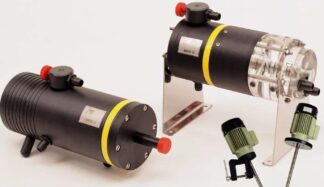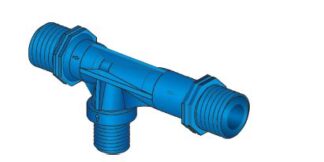Fertigation Pumps - Injectors
Fertigation is the injection of fertilizers, soil amendments, and other water-soluble products into an irrigation system.
Fertigation is related to chemigation, the injection of chemicals into an irrigation system. The two terms are sometimes used interchangeably however chemigation is generally a more controlled and regulated process due to the nature of the chemicals used. Chemigation often involves pesticides, herbicides, and fungicides, some of which pose health threat to humans, animals, and the environment.
Fertigation is practiced extensively in commercial agriculture and horticulture. Fertigation is also increasingly being used for landscaping as dispenser units become more reliable and easier to use. Fertigation is used to add additional nutrients or to correct nutrient deficiencies detected in plant tissue analysis. It is usually practiced on high-value crops such as vegetables, turf, fruit trees, and ornamentals.
Commonly used nutrients
Most plant nutrients can be applied through irrigation systems. Nitrogen is the most commonly used plant nutrient. Naturally occurring nitrogen (N2) is a diatomic molecule which makes up approximately 80% of the earth’s atmosphere. Most plants cannot directly consume diatomic nitrogen, therefore nitrogen must be contained as a component of other chemical substances which plants can consume. Commonly, anhydrous ammonia, ammonium nitrate, and urea are used as bioavailable sources of nitrogen. Other nutrients needed by plants include phosphorus and potassium. Like nitrogen, plants require these substances to live but they must be contained in other chemical substances such as monoammonium phosphate or diammonium phosphate to serve as bioavailable nutrients. A common source of potassium is muriate of potash which is chemically potassium chloride.[1] A soil fertility analysis is used to determine which of the more stable nutrients should be used.
Advantages
The benefits of fertigation methods over conventional or drop-fertilizing methods include:
Increased nutrient absorption by plants.
Reduction of fertilizer, chemicals, and water needed.
Reduced leaching of chemicals into the water supply.
Reduced water consumption due to the plant’s increased root mass’s ability to trap and hold water.
Application of nutrients can be controlled at the precise time and rate necessary.
Minimized risk of the roots contracting soil borne diseases through the contaminated soil.
Reduction of soil erosion issues as the nutrients are pumped through the water drip system.
Disadvantages
Concentration of the solution decreases as the fertilizer dissolves. This may lead to poor nutrient placement.
The water supply for fertigation is to be kept separate from the domestic water supply to avoid contamination.
Possible pressure loss in the main irrigation line.
The process is dependent on the water supply’s non-restriction by drought rationing.
Methods used
Drip irrigation-Less wasteful than sprinklers.
Sprinkler systems-Increases leaf and fruit quality.
Continuous application-Fertilizer is supplied at a constant rate.
Three-stage application-Irrigation starts without fertilizers. Fertilizers are applied later in the process.
Proportional application-Injection rate is proportional to water discharge rate.
Quantitative application-Nutrient solution is applied in a calculated amount to each irrigation block.
Other methods of application include the lateral move, the traveler gun, and solid set systems.
System design
Fertigation assists distribution of fertilizers for farmers. The simplest type of fertigation system consists of a tank with a pump, distribution pipes, capillaries, and a dripper pen.
All systems should be placed on a raised or sealed platform, not in direct contact with the earth. Each system should also be fitted with chemical spill trays.
Because of the potential risk of contamination in the potable (drinking) water supply, a backflow prevention device is required for most fertigation systems. Backflow requirements may vary greatly. Therefore, it is very important to understand the proper level of backflow prevention required by law. In the United States, the minimum backflow protection is usually determined by state regulation. Each city or town may set the level of protection required.




































